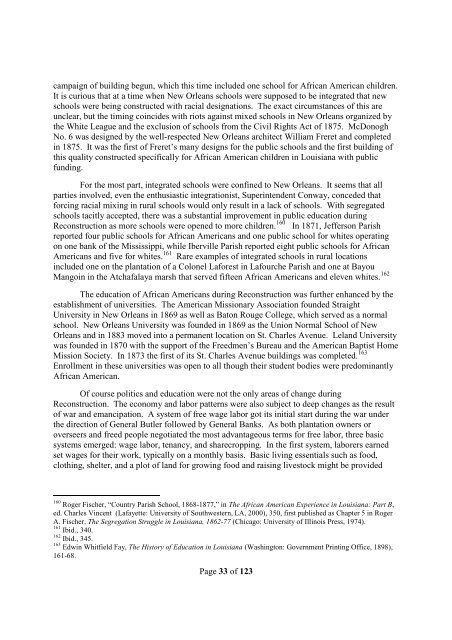The African American Experience in Louisiana
The_African_American_Experience_in_Louisiana
The_African_American_Experience_in_Louisiana
- No tags were found...
Create successful ePaper yourself
Turn your PDF publications into a flip-book with our unique Google optimized e-Paper software.
campaign of build<strong>in</strong>g begun, which this time <strong>in</strong>cluded one school for <strong>African</strong> <strong>American</strong> children.<br />
It is curious that at a time when New Orleans schools were supposed to be <strong>in</strong>tegrated that new<br />
schools were be<strong>in</strong>g constructed with racial designations. <strong>The</strong> exact circumstances of this are<br />
unclear, but the tim<strong>in</strong>g co<strong>in</strong>cides with riots aga<strong>in</strong>st mixed schools <strong>in</strong> New Orleans organized by<br />
the White League and the exclusion of schools from the Civil Rights Act of 1875. McDonogh<br />
No. 6 was designed by the well-respected New Orleans architect William Freret and completed<br />
<strong>in</strong> 1875. It was the first of Freret’s many designs for the public schools and the first build<strong>in</strong>g of<br />
this quality constructed specifically for <strong>African</strong> <strong>American</strong> children <strong>in</strong> <strong>Louisiana</strong> with public<br />
fund<strong>in</strong>g.<br />
For the most part, <strong>in</strong>tegrated schools were conf<strong>in</strong>ed to New Orleans. It seems that all<br />
parties <strong>in</strong>volved, even the enthusiastic <strong>in</strong>tegrationist, Super<strong>in</strong>tendent Conway, conceded that<br />
forc<strong>in</strong>g racial mix<strong>in</strong>g <strong>in</strong> rural schools would only result <strong>in</strong> a lack of schools. With segregated<br />
schools tacitly accepted, there was a substantial improvement <strong>in</strong> public education dur<strong>in</strong>g<br />
Reconstruction as more schools were opened to more children. 160 In 1871, Jefferson Parish<br />
reported four public schools for <strong>African</strong> <strong>American</strong>s and one public school for whites operat<strong>in</strong>g<br />
on one bank of the Mississippi, while Iberville Parish reported eight public schools for <strong>African</strong><br />
<strong>American</strong>s and five for whites. 161 Rare examples of <strong>in</strong>tegrated schools <strong>in</strong> rural locations<br />
<strong>in</strong>cluded one on the plantation of a Colonel Laforest <strong>in</strong> Lafourche Parish and one at Bayou<br />
Mango<strong>in</strong> <strong>in</strong> the Atchafalaya marsh that served fifteen <strong>African</strong> <strong>American</strong>s and eleven whites. 162<br />
<strong>The</strong> education of <strong>African</strong> <strong>American</strong>s dur<strong>in</strong>g Reconstruction was further enhanced by the<br />
establishment of universities. <strong>The</strong> <strong>American</strong> Missionary Association founded Straight<br />
University <strong>in</strong> New Orleans <strong>in</strong> 1869 as well as Baton Rouge College, which served as a normal<br />
school. New Orleans University was founded <strong>in</strong> 1869 as the Union Normal School of New<br />
Orleans and <strong>in</strong> 1883 moved <strong>in</strong>to a permanent location on St. Charles Avenue. Leland University<br />
was founded <strong>in</strong> 1870 with the support of the Freedmen’s Bureau and the <strong>American</strong> Baptist Home<br />
Mission Society. In 1873 the first of its St. Charles Avenue build<strong>in</strong>gs was completed. 163<br />
Enrollment <strong>in</strong> these universities was open to all though their student bodies were predom<strong>in</strong>antly<br />
<strong>African</strong> <strong>American</strong>.<br />
Of course politics and education were not the only areas of change dur<strong>in</strong>g<br />
Reconstruction. <strong>The</strong> economy and labor patterns were also subject to deep changes as the result<br />
of war and emancipation. A system of free wage labor got its <strong>in</strong>itial start dur<strong>in</strong>g the war under<br />
the direction of General Butler followed by General Banks. As both plantation owners or<br />
overseers and freed people negotiated the most advantageous terms for free labor, three basic<br />
systems emerged: wage labor, tenancy, and sharecropp<strong>in</strong>g. In the first system, laborers earned<br />
set wages for their work, typically on a monthly basis. Basic liv<strong>in</strong>g essentials such as food,<br />
cloth<strong>in</strong>g, shelter, and a plot of land for grow<strong>in</strong>g food and rais<strong>in</strong>g livestock might be provided<br />
160 Roger Fischer, “Country Parish School, 1868-1877,” <strong>in</strong> <strong>The</strong> <strong>African</strong> <strong>American</strong> <strong>Experience</strong> <strong>in</strong> <strong>Louisiana</strong>: Part B,<br />
ed. Charles V<strong>in</strong>cent (Lafayette: University of Southwestern, LA, 2000), 350, first published as Chapter 5 <strong>in</strong> Roger<br />
A. Fischer, <strong>The</strong> Segregation Struggle <strong>in</strong> <strong>Louisiana</strong>, 1862-77 (Chicago: University of Ill<strong>in</strong>ois Press, 1974).<br />
161 Ibid., 340.<br />
162 Ibid., 345.<br />
163 Edw<strong>in</strong> Whitfield Fay, <strong>The</strong> History of Education <strong>in</strong> <strong>Louisiana</strong> (Wash<strong>in</strong>gton: Government Pr<strong>in</strong>t<strong>in</strong>g Office, 1898),<br />
161-68.<br />
Page 33 of 123


